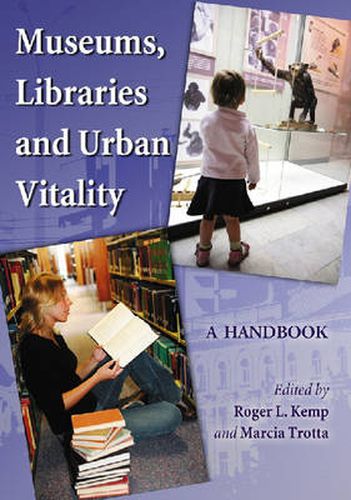Readings Newsletter
Become a Readings Member to make your shopping experience even easier.
Sign in or sign up for free!
You’re not far away from qualifying for FREE standard shipping within Australia
You’ve qualified for FREE standard shipping within Australia
The cart is loading…






This title is printed to order. This book may have been self-published. If so, we cannot guarantee the quality of the content. In the main most books will have gone through the editing process however some may not. We therefore suggest that you be aware of this before ordering this book. If in doubt check either the author or publisher’s details as we are unable to accept any returns unless they are faulty. Please contact us if you have any questions.
This volume documents the growing trend for cities and towns throughout America to use museums and libraries as vehicles for economic development. Museums of all types and sizes, and libraries from main street behemoths to neighborhood branches, are being used to stimulate inner-city revitalization as well as neighborhood renewal programs. These public amenities draw citizens, tourists and new development to a city’s venues, providing a public place for people to focus and gather. In short, the small public investment paid for these cultural centers is much less then the dollars returned to taxpayers from tourism and economic development.This collection of essays presents case studies from Austin, Baltimore, Boston, Brooklyn, Charleston, Christchurch, Cincinnati, Denver, Des Moines, Hartford, Germantown, Indianapolis, Kansas City, Lanark, Little Rock, Memphis, Minneapolis, Miramar, Pekin, Philadelphia, Phoenix, Portland, Prince Rupert, St. Louis, St. Paul, San Jose, Seattle, Tacoma, Tallahassee, Toronto, Valencia, and Wakefield. The case study topics include the role of museums and libraries in promoting urban renewal and downtown redevelopment, revitalizing urban centers, enhancing ‘smart communities,’ influencing eco-friendly municipal construction trends, and stimulating private development. The work includes several regional and national resource directories, a glossary, and an index to facilitate reference to particular communities and projects throughout the country.
$9.00 standard shipping within Australia
FREE standard shipping within Australia for orders over $100.00
Express & International shipping calculated at checkout
This title is printed to order. This book may have been self-published. If so, we cannot guarantee the quality of the content. In the main most books will have gone through the editing process however some may not. We therefore suggest that you be aware of this before ordering this book. If in doubt check either the author or publisher’s details as we are unable to accept any returns unless they are faulty. Please contact us if you have any questions.
This volume documents the growing trend for cities and towns throughout America to use museums and libraries as vehicles for economic development. Museums of all types and sizes, and libraries from main street behemoths to neighborhood branches, are being used to stimulate inner-city revitalization as well as neighborhood renewal programs. These public amenities draw citizens, tourists and new development to a city’s venues, providing a public place for people to focus and gather. In short, the small public investment paid for these cultural centers is much less then the dollars returned to taxpayers from tourism and economic development.This collection of essays presents case studies from Austin, Baltimore, Boston, Brooklyn, Charleston, Christchurch, Cincinnati, Denver, Des Moines, Hartford, Germantown, Indianapolis, Kansas City, Lanark, Little Rock, Memphis, Minneapolis, Miramar, Pekin, Philadelphia, Phoenix, Portland, Prince Rupert, St. Louis, St. Paul, San Jose, Seattle, Tacoma, Tallahassee, Toronto, Valencia, and Wakefield. The case study topics include the role of museums and libraries in promoting urban renewal and downtown redevelopment, revitalizing urban centers, enhancing ‘smart communities,’ influencing eco-friendly municipal construction trends, and stimulating private development. The work includes several regional and national resource directories, a glossary, and an index to facilitate reference to particular communities and projects throughout the country.